CAA News Today
J20 Art Strike Closure
posted by admin — January 19, 2017
 CAA is taking part in the J20 Art Strike, an Act of Noncompliance on Inauguration Day. We apologize if this has caused you any inconvenience, but we consider this action important to take. This call concerns more than the art field. It is made in solidarity with the nation-wide demand that on January 20 and beyond, business should not proceed as usual.
CAA is taking part in the J20 Art Strike, an Act of Noncompliance on Inauguration Day. We apologize if this has caused you any inconvenience, but we consider this action important to take. This call concerns more than the art field. It is made in solidarity with the nation-wide demand that on January 20 and beyond, business should not proceed as usual.
For more information on the J20 Art Strike, including the long list of art critics, artists, curators, and institutions taking part please visit the J20 Art Strike website.
Online registration for the Annual Conference, February 15-18 in New York, will remain open.
We will be back in the office on January 23, 2017.
News from the Art and Academic Worlds
posted by Christopher Howard — January 18, 2017
Each week CAA News summarizes eight articles, published around the web, that CAA members may find interesting and useful in their professional and creative lives.
Controversial Capitol Painting by Former St. Louis Student Taken Down
The painting by a former St. Louis high school student was removed over the Martin Luther King Jr. holiday weekend. Rep. Dave Reichert, who petitioned its removal, said it would be taken down by the Architect of the Capitol’s office, which ultimately determines the art that hangs on the walls of the congressional art competition. On Tuesday morning, not only was the painting gone, but the placard describing it was removed, too. (Read more from the St. Louis Post-Dispatch.)
What’s Missing in the Teaching of Islam
In high school history books, there is little mention of the intertwined histories of Europe, Asia, and Africa in the middle ages and the Renaissance. There is even less mention of the flowering of art, literature, and architecture during this time. (Read more from the Conversation.)
Keeping God Out of the Gallery
“My work has proven to be difficult to place in commercial art galleries,” said the painter Edward Knippers. Well, we’ve heard that before. Plenty of artists say the problem isn’t the quality of their work but the gallery owner’s narrow-mindedness or something to that effect. But Knippers, a figurative painter of biblical subjects, said the real problem is what he chooses to paint: religious figures. (Read more from the Observer.)
Learning from Decolonize This Place
“You can’t talk about indigenous struggle without indigenous people involved,” said the artist, activist, and MTL+ cofounder Amin Husain. He was explaining a core principle of Decolonize This Place, a three-month residency that brought together multiple movements at the New York nonprofit Artists Space for art making, organizing, and activism, all based around direct actions targeting five issues: Free Palestine, Indigenous Struggle, Black Liberation, Global Wage Workers, and de-gentrification. (Read more from Hyperallergic.)
Citizenship, the Body, and the Ethics of Exposure
We live in a society that relishes exposure—see nude photo leaks, the Kardashians, and diaries and private correspondence cloaked with the pretense of literary or political interest—and that does not value privacy equally for all. On top of the inequity, unmediated exposure does not exist. There is always an implicit or explicit narrative being constructed in the act of baring. (Read more from Art Practical.)
Art Museums by the Numbers 2016
First released in 2014, Art Museums by the Numbers is based on aggregated data drawn from AAMD’s member survey and tracks changes over time. Comparisons between 2014, 2015, and 2016 data show little fluctuation, indicating continued stability in the field of art museums. (Read more from the Association of Art Museum Directors.)
Why Art History Might Be the Most Important Subject You Could Study Today
We Americans tend to think of the British as infinitely more refined and cultivated than we are, but England almost eliminated art history as a field of study for high school students. But after much protest from the liberal intellectual establishment, art history was “saved” and will stay on British curricula. If the cultured British nearly did away with art history, then what hope have we Americans? (Read more from Salon.)
The Problem of Predatory Journals: Fake Academia Joins Fake News
We’ve heard all about fakes this year: fake scandals, fake food, fake news. Now fraud emerges from an unexpected corner: academia—or rather, its counterfeit. Fraudulent academic groups have been soliciting papers from researchers for conferences and journals, but do not adhere to publication standards like peer review; instead, they accept papers unquestioningly and charge authors enormous fees. (Read more from Nonprofit Quarterly.)
Committee on Women in the Arts Picks January 2017
posted by CAA — January 16, 2017
Each month, CAA’s Committee on Women in the Arts selects the best in feminist art and scholarship. The following exhibitions and events should not be missed. Check the archive of CWA Picks at the bottom of the page, as several museum and gallery shows listed in previous months may still be on view or touring.
January 2017
The Future is Female
21c Museum Hotel
700 West Main Street, Louisville, Kentucky
November 2016–May 2017
The Future is Female at the Louisville, KY, 21c Museum Hotel, features feminist art from the 21c collection, including painting, video, photography, and installation. Works on view include pieces by Carrie Mae Weems, Jenny Holzer, Nandipha Mntambo, Kiki Smith, and Frances Goodman, among many others. “Gleaming acrylic fingernails glued into patterned, reptilian forms that emerge from the wall; barnacles and ceramic teeth encrusted in life-size human figures in decay; cement seeping through lace and paint; haunting words about the present overlaid on imagery of the past: surface tension abounds in this exploration of contemporary feminist art.”
Curated by Alice Gray Stites, chief curator and museum director, the exhibition fuses celebration and critique through engaging and evocative art. In Alison Saar’s work on view, Hades D.W.P., five glass jars are filled with water to varying levels. Each jar is “tagged with lines of poetry, their surfaces etched with figures that float between life and death.” While the work hints the water is meant for drinking, its toxic colors indicate otherwise, alluding to the drinking water disaster in Flint, Michigan.

Pat Oleszko: Fool for Thought
Women’s Studies Research Center/Kniznick Gallery
Brandeis University, Epstein Building, 515 South Street, Waltham, MA
November 21, 2016–March 3, 2017
The visual and performance artist Pat Oleszko brings her signature style to the Kniznick Gallery, which presents an exhibition of her costumes, inflatables, videos, and props. “With elaborate handmade costumes and props, Oleszko utilizes the body as armature for ideas in an array of lampoons that call her audience to action.” Through humor and the absurd, Oleszko touches on issues from the personal to the political. Fool for Thought highlights her performances, including Hello Folly: The Floes & Cons of Arctic Drilling, Oldiloks and the Bewares, Stalking Walking Topiary, and the Pat and the Hats. Self-identified as the Fool in question and the questioning Fool, Oleszko fans the flames with rousing absurdity and maintains that she who laughs, lasts.
The exhibition also includes several events, including an artist’s lecture with Oleszko and a reception on January 25 and a lecture on February 2 with Barbara Bodenhorn. The lecture will focus on the combination of art and science as it seeks to engage young people in ecologically vulnerable regions.
A Woman’s Afterlife: Gender Transformation in Ancient Egypt
tBrooklyn Museum
200 Eastern Parkway, Brooklyn, New York
Starting December 15, 2016
Through new research and scholarship, the Egyptian artifacts in A Woman’s Afterlife explore the gender transformation of deceased women and the difference between male and female access to the afterlife. The exhibition is part of A Year of Yes: Reimagining Feminism at the Brooklyn Museum, a yearlong project celebrating a decade of feminist thinking at the institution.
“Egyptian medicine taught that a woman, once in her tomb, faced a biological barrier to rebirth. Because the ancient Egyptians believed that in human reproduction it was the man who created the fetus, transferring it to the woman during intercourse, rebirth was impossible for a woman alone.” It was the priest’s role to magically transform the woman’s mummy into a man, thus creating a fetus. This was accomplished through incanted spells with masculine pronouns, graphic representations of those spells on the coffin, and adding red skin—a color assigned to men. The centerpiece, a painted coffin and mask of Weretwahset, exemplifies these steps and depicts her fleeting transformation from female to male.
The exhibition was sparked by researched published by the scholars Kathlyn M. Cooney (University of California, Los Angeles), Heather McCarthy (New York University), Gay Robins (Emory University), and Ann Macy Roth (New York University). “This research has led to a better understanding of the logic behind this unexpected gender transformation by discovering that women were intentionally represented with red skin and with masculine pronouns. Previously, these representations were regarded as mere mistakes,” said Edward Bleiberg, curator of Egyptian art. “Feminism has changed the questions we ask of ancient history as well as the answers we offer. This is a striking example of how feminism has provided a basis for new scholarship that reinterprets an ancient puzzle.”
Catalina Schliebener: Growing Sideways
Bureau of General Services—Queer Division
208 West 13th Street, Room 210, New York
Open until January 22, 2017
The Bureau of General Services Queer Division presents Growing Sideways, an exhibition of new work by the Buenos Aires–based Chilean artist Catalina Schliebener (b. Santiago, 1980). Organized by the independent curator John Chaich, the exhibition takes its title—and somewhat its conceptual and formal inspiration—from the queer scholar Kathryn Stockton Bond’s notion that rather than the normative view of “growing up,” the nonstraight child grows sideways through life-long, lateral interactions between childhood motivations and adult identifications, formed by sly intentions, blurred chronologies, and animalistic attachments.
Growing Sideways presents over five dozen drawings on collage that frame the space and culminate in a floor-to-ceiling mural, growing across two- and three-dimensional surfaces and creating a disjointed narrative exploring gender formation and erotic curiosity through Schiebener’s combination of cuttings from found children’s books with abstract drawings and vinyl mural recalling organic sensual shapes in nature and the body. An artist-curated selection of books accompanies the site-specific installation.
A dialogue with the artist, Chaich, and Kris Grey will take place on January 12, 2017, at 7:00 PM.
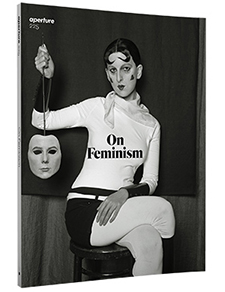
On Feminism
Aperture #225 (Winter 2016)
Aperture’s winter issue has focused “On Feminism.” In a moment that the very idea of gender is central to local and global conversations about equality, this approach arrives at a right moment to address the power and influence that women hold on the stage of the art world and beyond.
This issue focuses on intergenerational dialogues, debates, and strategies of feminism in photography, acknowledging the immense contributions by artists whose work articulates or interrogates representations of women in media and society. “On Feminism” features include a lively roundtable with curators from Paris and New York on modernist photographers between the wars, Nancy Princenthal on the feminist avant-garde of the 1970s, Eva Díaz on protest and visual politics, Laura Guy on lesbian erotica as critical rebellion, Eva Respini on abstraction, Julia Bryan-Wilson on visions of trans feminism, and a conversation with Renée Cox about black feminist icons, plus contributions from Martha Rosler and Maria Nicolacopoulou, among others, as well as portfolios by Farah Al Qasimi, Jennifer Blessing, Zackary Drucker, Catherine Morris, A. L. Steiner, Zanele Muholi, Yurie Nagashima, Elle Pérez, Laurie Simmons, Cosey Fanni Tutti, and Gillian Wearing.
The issue’s contents are organized in two main sections that underscores how photography has shaped feminism as much as how feminism has shaped photography. Use #OnFeminism to join the conversation on Twitter, Instagram, and Facebook.
Nairy Baghramian: Déformation Professionnelle
S.M.A.K.
Jan Hoetplein 1, 9000 Ghent, Belgium
November 26, 2016–February 19, 2017
S.M.A.K. presents Déformation Professionnelle, a solo exhibition by influential Iranian sculptor Nairy Baghramian. Born in 1971 in Isfahan, Iran, Baghramian is currently living and working in Berlin. She has become internationally known for her contextual approach to exhibition-making via sculpture and photography. Focusing in a site-responsive practice, her works explore the body and its supportive functions.
Déformation Professionnelle is a new production which builds on eighteen works in the artist’s oeuvre from 1999 to 2016. Baghramian alludes to existing work from discarded ideas to working material. In the artist’ words, she is “surveying the survey.” This body of work formulates fundamental questions about progress and economy, while interrogating what happens when something ceases to exist, and how something new comes into being.
The exhibition includes several large-scale works such as Class Reunion (2008), Retainer (2012), and French Curve (2014). Both inside and outside the museum,the display evidences the artist complex engagement with the transformation and consequent deformation of form, language, and meaning in its translation from one series into the other.
Nairy Baghramian | Déformation Professionnelle is organized by S.M.A.K. and the Walker Art Center in Minneapolis, where the exhibition will travel in October 2017.
Affiliated Society News for January 2017
posted by CAA — January 15, 2017
Association of Academic Museums and Galleries
The Association of Academic Museums and Galleries (AAMG) welcomes a new board member, Jamaal B. Sheats. Sheats is the director and curator of the Fisk University Galleries and assistant professor in the Fisk University Art Department. He has simultaneously maintained a strong and consistent exhibition record for nearly fifteen years in galleries across the nation and abroad. Most recently, Sheats curated Carl Van Vechten: Depth of Field; Selections from the Fisk University Galleries and the John Hope and Aurelia E. Franklin Library Collection and Origins of Influence: The Alfred Stieglitz Collection of Modern Art at the Carl Van Vechten Art Gallery at Fisk University. He also completed a commission for the National Museum of African American Music. In 2015, Sheats organized the exhibition Topography at Tinney Contemporary Art Gallery in Nashville, Tennessee.
Sheats was commissioned to create Eight Octives for Music City Center in 2013. In addition to his appointments at Fisk, active art-making, exhibitions, and curatorial projects, he is the owner of Sheats Repoussé and the Charlotte Art Project. He continues to receive accolades for his work. In 2016 his exhibitions Origins of Influence and Topography were voted by the editors of the Nashville Scene as “Best Art Comeback” and “Best Group Exhibit,” respectively. Sheats has also been featured in the Boston Globe, the New York Times, Numbers, and Nashville Arts Magazine, as well as several other arts journals, newspapers, and magazines.
To support his commitment to the arts and art education, Sheats is active in the arts community and holds positions on the Frist Center for the Arts Education Council, the “To Share a Legacy” HBCU Alliance, the Nashville Conference on African-American History Culture planning committee, and the “Plan to Play” Steering Committee for the Metro Parks and Recreation. He is a board member of the Arts and Business Council also.
Sheats obtained his BA degree in art from Fisk University and an MFA degree with a concentration in studio art from the School of the Museum of Fine Art, Boston, and Tufts University, where he also completed a postgraduate teaching fellowship. Sheat was a teaching artist-in-residence at the Nashville Public Library.
View the complete list of AAMG board members.
Association of Art Historians
The Association of Art Historians’ (AAH) 2017 annual conference and art-book fair will take place April 6–8, 2017, at Loughborough University. The keynote speakers are: Amelia Jones, Robert A. Day Professor in Art and Design and Vice Dean of Critical Studies at the Roski School of Art and Design at the University of Southern California in Los Angeles, who will speak on “Intimate Relations: Queer Performance in Art History”; and Mark Hallett, director of studies at the Paul Mellon Center for Studies in British Art, who will address “Interactive Landscapes: From Thomas Gainsborough to George Shaw.”
The conference will celebrate the expansive spectrum of histories, theories, and practices that characterize art-historical research today. Internationally, the field of art history is eclectic and inclusive, reaching across geopolitical, cultural, and disciplinary divides to extend an understanding of the visual and material culture of many diverse periods and places. Loughborough University is engaged with art history, contemporary practice, and visual culture, linking arts-based research with advances in design, technology, media, and communication, centered on the development of more sustainable and equitable global communities. Full details and register information can be found on the AAH website.
New Media Caucus
The New Media Caucus (NMC) will be sponsoring a series of programs during CAA’s upcoming 2017 Annual Conference. Programs include panels, the annual showcase, and a membership business meeting where important news about NMC will be announced. More information can be found online.
The annual NMC business meeting will take place on Thursday, February 16, 1:30–3:00 PM. All members are invited. We will gather to discuss new developments and initiatives for the growth of our organization. Next is NMC’s panel, “Other Media: Decolonizing Practices and Cyborg Ontologies,” to be held 3:30–5:00 PM. The session will be followed at 7:00 PM with the NMC showcase in the Lang Auditorium at Hunter College, Main Campus, 695 Park Ave at 68th Street, New York, NY 10065. The showcase is a highlight of NMC’s events at CAA and will feature presentations by twenty new media artists who will talk about their current research. The showcase is followed by a public reception. On Friday, February 17, NMC has scheduled three events in the CAA Media Lounge: “Roundtable: New Media Futures” at 10:30 AM; “Game Studies at 20” at 1:30 PM; and “Between Biology and Art” at 3:30 PM.
Renaissance Society of America
The Renaissance Society of America (RSA) will hold its sixty-third annual meeting at the Palmer House Hilton Hotel in Chicago from March 30 to April 1, 2017. Some two hundred art-history sessions are featured in the program, as well as a plenary lecture by Paul Hills, professor emeritus at the Courtauld Institute of Art, taking place on Saturday, April 1, at noon. The conference program is available online, as well as information about fees and other practicalities.
Meanwhile, the society is sponsoring a session on “Early Modern Senses and Spaces” at the CAA Annual Conference in New York, scheduled for Wednesday, February 15, at 10:30 AM in Sutton Parlor South, 2nd Floor. RSA’s executive director plans to attend and hopes to see many RSA and CAA members there.
RSA offers numerous fellowships for art historians, including Samuel H. Kress Research Library Fellowships, Samuel H. Kress Mid-Career Research and Publication Fellowships in Renaissance Art History, the RSA-Kress Carlo Pedretti Fellowship in Leonardo da Vinci Studies, and our own RSA Fellowships. The next deadline for applications will be in fall 2017.
The winter 2016 issue of Renaissance Quarterly (vol. 69, no. 4) includes an article on “Vicenzo Danti’s Deceits,” coauthored by Michael Cole and Diletta Gamberini.
RSA is pleased to announce that James Shulman, senior fellow at the Andrew W. Mellon Foundation and former president of Artstor, has joined RSA’s executive board in July 2016 as a counselor.
Society for Photographic Education
Registration is open for the Society for Photographic Education’s (SPE) fifty-fourth national conference, “Family Values,” taking place March 9–12, 2017, in Orlando, Florida. Connect with artists, educators, and photographers from around the world for programming that will fuel your creativity—four days of presentations, industry seminars, and critiques to engage you! Explore an exhibits fair featuring the latest equipment, processes, publications, and photography/media schools. Participate in one-on-one portfolio critiques and informal portfolio sharing, and take advantage of student volunteer opportunities to receive a full rebate on admission. Other highlights include a print raffle, a silent auction, mentoring sessions, film screenings, exhibitions, receptions, a dance party, and more! The guest speakers are Renee Cox, LaToya Ruby Frazier, and Jerry Uelsmann. Preview the conference schedule and register online. Preregistration ends on February 17, 2017. Don’t wait, register today!
Society of Historians of East European, Eurasian, and Russian Art and Architecture
Members of the Society of Historians of East European, Eurasian, and Russian Art and Architecture (SHERA) took an active part in the forty-eighth convention of the Association of Slavic, East European, and Eurasian Studies in Washington, DC, organizing several panels and roundtable discussions. At the membership meeting held during the convention, matters of importance to the life of the organization were discussed, such as the upcoming conference in Venice in October 2017; possible replacement of a listserv communication platform with a network-based one; reelection of officers; and distribution of prizes and awards.
At CAA’s Annual Conference in February 2017, SHERA will sponsor the following double session: “Emerging Scholars: Politics and the Collective in East European and Russian Art: Part I,” taking place on Wednesday, February 15, 2017, at 10:30 AM in West Ballroom, 3rd Floor; and “Emerging Scholars: Russian Artists and International Communities: Part II,” to be held on Friday, February 17, 2017, at 8:30 AM in Sutton Parlor South, 2nd Floor. Both sessions will be chaired by Alice Isabella Sullivan, a PhD candidate at the University of Michigan in Ann Arbor.
Visual Resources Association
The Visual Resources Association (VRA) has opened registration for its thirty-fourth annual conference, to be held March 28–April 1, 2017, in Louisville, Kentucky. Early-bird rates are good through February 28. Registration will continue online at the full rate until March 17, then continue onsite the week of the conference. Current members will be prompted to log in with MemberClicks ID-password through the registration form, while nonmembers will have the opportunity to join or register through the same single form. The payment structure for workshops is new: one workshop is included in the registration fee, and any additional workshops are $15 each. You can submit multiple conference registration forms. This may be helpful if using multiple forms of payment (institutional credit card for registration and personal card for tours, for example).
Check the conference schedule for event details and updates. Workshops and tours fill up fast and are on a first-come, first-served basis. Once the enrollment limits are reached, registration for them closes. If there is something you are really interested in, it is best to act early. Contact VRA’s secretary, Jasmine Burns, with any questions or registration changes. The conference website includes information about rates and date ranges for registration, the welcome letter from VRA president Jen Green, tips for travel to and from Louisville and the Marriott Hotel, and more.
New in caa.reviews
posted by admin — January 13, 2017
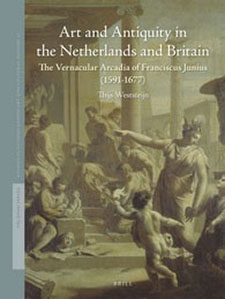 Michael Yonan visits Wordplay: Matthias Buchinger’s Drawings from the Collection of Ricky Jay at the Metropolitan Museum of Art. The artist “was born without legs or hands” and created micrography, “a technique whereby minutely drawn words create an image.” The “small but excellent” exhibition managed to “illuminate the life of a little-known historical figure” and “examine a historically significant art form.” Read the full review at caa.reviews.
Michael Yonan visits Wordplay: Matthias Buchinger’s Drawings from the Collection of Ricky Jay at the Metropolitan Museum of Art. The artist “was born without legs or hands” and created micrography, “a technique whereby minutely drawn words create an image.” The “small but excellent” exhibition managed to “illuminate the life of a little-known historical figure” and “examine a historically significant art form.” Read the full review at caa.reviews.
Margit Thøfner reviews Art and Antiquity in the Netherlands and Britain: The Vernacular Arcadia of Franciscus Junius (1591–1677) by Thijs Weststeijn. This “well-researched, thoughtful, and timely” book argues “for the seminal role” played by Junius’s The Painting of the Ancients in Three Books “within the history of early modern Netherlandish art theory and also in the broader European tradition.” Read the full review at caa.reviews.
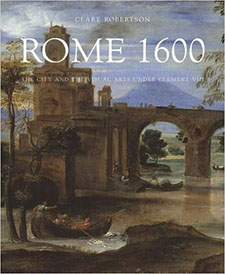 Jeffrey Fraiman reviews Clare Robertson’s Rome 1600: The City and the Visual Arts under Clement VIII. It is a “comprehensive study of the plenitude of projects commissioned by various patrons” in the “tumultuous and transforming” time during the reign of Clement VIII. The publication “transports readers to Rome circa 1600” and “will surely inspire valuable new directions in research.” Read the full review at caa.reviews.
Jeffrey Fraiman reviews Clare Robertson’s Rome 1600: The City and the Visual Arts under Clement VIII. It is a “comprehensive study of the plenitude of projects commissioned by various patrons” in the “tumultuous and transforming” time during the reign of Clement VIII. The publication “transports readers to Rome circa 1600” and “will surely inspire valuable new directions in research.” Read the full review at caa.reviews.
caa.reviews publishes over 150 reviews each year. Founded in 1998, the site publishes timely scholarly and critical reviews of studies and projects in all areas and periods of art history, visual studies, and the fine arts, providing peer review for the disciplines served by the College Art Association. Publications and projects reviewed include books, articles, exhibitions, conferences, digital scholarship, and other works as appropriate. Read more reviews at caa.reviews.
Pearson at the CAA Conference
posted by admin — January 12, 2017
 The Pearson Art team is excited to be a part of the upcoming CAA Conference in New York City!
The Pearson Art team is excited to be a part of the upcoming CAA Conference in New York City!
Come Visit Us at the Booth!
Stop by Pearson’s booth #505/507 to take part in our student-lead Revel demonstrations. All demo participants will be entered into a raffle to win the grand prize of an iPad mini! While at the booth you will also be able to see the new 6th edition of Stokstad & Cothren’s Art History.
Please join us in honoring the memory of Art History’s lead author, Marilyn Stokstad, at our booth reception at 3:00 pm on Friday, February 17th. We will also be hosting a Manhattan’s for Marilyn reception following the Marilyn Stokstad: A Memorial Roundtable session at 5:30 pm later that same day. All are welcome to attend.
In addition, Pearson is proud to announce the Marilyn Stokstad Graduate Student Scholarship which has been created to help pass on Marilyn’s legacy to the next generation of Art History teachers. We will have more details on this opportunity for your students available at the booth.
Participate in a Focus Group
On Thursday, February 16th & Friday, February 17th, we will be hosting a series of focus groups. We’re looking to connect with faculty members who specifically teach Art History survey courses. Each session is 90 minutes and participants will receive a $100 honorarium. Light snacks and refreshments will be served.
Interested in signing up? Please complete this brief survey to RSVP.
Space is limited so please reply right away if you are able to attend. We will try to accommodate as many respondents as possible.
Thank you and we are looking forward to seeing you in New York City!
Sincerely,
The Pearson Art Team
News from the Art and Academic Worlds
posted by Christopher Howard — January 11, 2017
Each week CAA News summarizes eight articles, published around the web, that CAA members may find interesting and useful in their professional and creative lives.
How to Start a Gallery in Your Apartment
As commercial real estate balloons in cities like New York and London, and art galleries professionalize, limiting the freedoms artists are given within their spaces, artists, art professionals, and collectors have begun to make use of living space—be it an entire apartment, a guest bedroom, or even a walk-in closet—to put on the shows they want to see. (Read more from Artsy.)
Bad Times Make Great Art: Worry Less about the Art and More about the Artists
On election night a murmur started just as the last gasp faded, “Well at least we can expect some great art.” It didn’t take long for the fatalistic statement to acquire a predictive tone, eventually a waft of desperation was detectable and, ultimately, shrill fiat. The art of protest is provocative, no question. It’s often brave, usually fierce, sometimes compelling, and occasionally inspirational. (Read more from Salon.)
In the Aftermath of Oakland’s Tragedy, How Museums Can Better Serve Local Arts and DIY Venues
Museums and art institutions have largely remained distant from the Ghost Ship incident in Oakland. This perpetuates the assumption that warehouse spaces are fringe—and even irrelevant—to the formal art world. In fact, the reality is quite the opposite. (Read more from Smithsonian Magazine.)
The Ten Technologies Defining Art Right Now
Ways of making and seeing, both new and old, have defined the art in 2016 every bit as much as the hot topics under exploration. Artnet News looks back at a year of exhibitions, biennials, and art fairs to identify the ten practices that stood out as significant in helping expand the definition of what art can be, as well as dying technologies that are revisited before becoming obsolete. (Read more from Artnet News.)
Layering and Mixing with Iridescent and Interference Acrylic Paints
We’ve all seen iridescent and interference effects when viewing soap bubbles, oil slicks, flower petals, bird feathers, and more. They are common in the natural world. If they are somewhat less common in artwork, it might simply be that they still represent new and unexplored possibilities for most people, even after being part of the artists’ palette for many decades at this point. (Read more from Just Paint.)
How Can We Minimize Grade Changes?
One of the most consequential lessons I learned last semester happened after it was over. Five days after the semester ended, the emails started coming in. I’m sure you get them too: the earnest and pleading requests (sometimes polite, sometimes not) for better grades. I responded with my general policy (I only change grades if I’ve made a mistake; I round to the nearest whole number), and that seemed to satisfy most students. But one student was a tougher nut to crack. (Read more from Vitae.)
An Idiosyncratic Timeline of “Attempts to Fix the Art World”
The term “the artworld” itself seems to date only to 1964, but this timeline goes all the way back to 1793, when the revolutionary regime in France turned a certain royal palace in Paris into a public museum. The history here is selective, to be sure, but half the fun of these things is working up righteous high dudgeon over what’s been included and excluded. (Read more from ARTnews.)
How Do We Make American Museums Multilingual?
Which languages should institutions prioritize? Should choices be based on current patrons or on visitors they’d like to reach? How fully should the selected languages be incorporated into the museum: Wall text? Audio? Catalogues? Tours? Ancillary programming? Outreach? (Read more from Hyperallergic.)
2017 Recipients of CAA’s Awards for Distinction
posted by admin — January 09, 2017
CAA announces the recipients of the 2017 Awards for Distinction, which honor the outstanding achievements and accomplishments of individual artists, art historians, authors, conservators, curators, and critics whose efforts transcend their individual disciplines and contribute to the profession as a whole and to the world at large.
CAA will formally recognize the honorees at a special awards ceremony to be held during Convocation at the 105th Annual Conference in New York, on Wednesday, February 15, 2017, at 5:30 PM. See the conference website for full details.
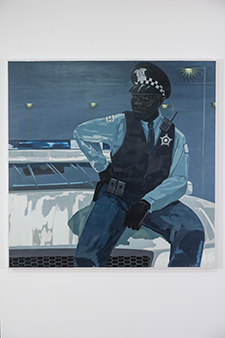
Kerry James Marshall, Untitled (policeman), 2015, acrylic on PVC panel, 60 x 60 inches, 60 9/16 x 60 1/2 x 2 3/4 inches (framed) © Kerry James Marshall. Courtesy of the artist and Jack Shainman Gallery, New York.
Among the winners this year is Kerry James Marshall, recipient of the 2017 CAA Artist Award for Distinguished Body of Work. In his 35-year career painting and making art, Marshall has depicted the African American experience through a medium that has often overlooked the lives of black Americans. His current retrospective at the Met Breuer, titled “Kerry James Marshall: Mastry” (October 25, 2016–January 29, 2017), brings together nearly 80 works by Marshall. Holland Cotter in The New York Times wrote of the show glowingly: “Mr. Marshall has absorbed enough personal history, American history, African-American history and art history to become one of the great history painters of our time.”
Kerry James Marshall biography
Faith Ringgold, the winner of the 2017 CAA Distinguished Artist Award for Lifetime Achievement, is widely considered one of the most influential living African American artists. Born in Harlem in 1930, she is an artist, feminist, activist, and educator who makes use of a variety of media, including painting, quilts, sculpture, performance, and children’s books. Civil Rights, racial justice, feminism, and art history are consistent themes. Ringgold earned BS and MA degrees in art from the City College, the City University of New York, and taught in the NYC public school system for almost twenty years. Since the 1970s Ringgold has been an activist and cofounder of several feminist and antiracist organizations, along with artist Poppy Johnson, art critic Lucy Lippard, and her daughter Michelle Wallace, among others.
Full list of 2017 CAA Awards for Distinction recipients
Charles Rufus Morey Book Award
Kishwar Rizvi
The Transnational Mosque: Architecture and Historical Memory in the Contemporary Middle East
University of North Carolina Press
Alfred H. Barr Jr. Award
Ruth Fine, ed.
Procession: The Art of Norman Lewis
Pennsylvania Academy of the Fine Arts, in association with the University of California Press
Alfred H. Barr Jr. Award for Smaller Museums, Libraries, Collections, and Exhibitions
Carmella Padilla and Barbara Anderson, eds.
A Red Like No Other: How Cochineal Colored the World
Skira Rizzoli, in association with the Museum of International Folk Art
Arthur Kingsley Porter Prize
Christine I. Ho
“The People Eat for Free and the Art of Collective Production in Maoist China”
The Art Bulletin, September 2016
Frank Jewett Mather Award for Art Criticism
Laura U. Marks
Hanan al-Cinema: Affections for the Moving Image
MIT Press
Distinguished Feminist Award
Joan Marter
Art Journal Award
Amy A. DaPonte
“Candida Höfer’s Türken in Deutschland as ‘Counter-publicity’”
Art Journal, Winter 2016
Distinguished Teaching of Art Award
Virginia Derryberry
Distinguished Teaching of Art History Award
Patricia Mainardi
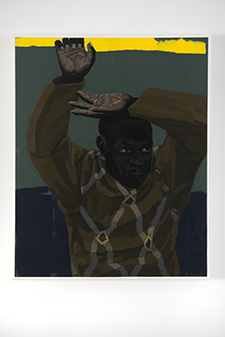
Kerry James Marshall, Untitled (Looking Man), 2016, acrylic on PVC panel, 30 1/2 x 24 1/2 inches, © Kerry James Marshall. Courtesy of the artist and Jack Shainman Gallery, New York.
Artist Award for Distinguished Body of Work
Kerry James Marshall
Distinguished Artist Award for Lifetime Achievement
Faith Ringgold
CAA/American Institute for Conservation Award for Distinction in Scholarship and Conservation
Tom J. S. Learner
Morey and Barr Award Finalists
CAA recognizes the 2017 finalists for the Charles Rufus Morey Book Award and the Alfred H. Barr Jr. Awards for their distinctive achievements:
Charles Rufus Morey Book Award Finalists
- Niall Atkinson, The Noisy Renaissance: Sound, Architecture, and Florentine Urban Life, Pennsylvania State University Press
- Elizabeth Kindall, Geo-Narratives of a Filial Son: The Paintings and Travel Diaries of Huang Xiangjian (1609–1673), Harvard University Asia Center
Alfred H. Barr Jr. Award Finalists
- Helen Molesworth, ed., Kerry James Marshall: Mastry, Museum of Contemporary Art, Chicago, and Skira Rizzoli (honorable mention)
- Barbara Haskell and Harry Cooper, Stuart Davis: In Full Swing, National Gallery of Art, Whitney Museum of American Art, and DelMonico Books
- Alisa LaGamma, Kongo: Power and Majesty, Metropolitan Museum of Art
- Adrian Sudhalter, Dadaglobe Reconstructed, Kunsthaus Zürich and Scheidegger & Spiess
Alfred H. Barr Jr. Award for Smaller Museums, Libraries, Collections, and Exhibitions Finalists
- Andreas Marks, ed., Tōkaidō Texts and Tales: Tōkaidō “gojūsan tsui” by Kuniyoshi, Hiroshige, and Kunisada, University Press of Florida (honorable mention)
- Zdenka Badovinac, Eda Čufer, and Anthony Gardner, eds., NSK from “Kapital” to Capital: Neue Slowenische Kunst—An Event of the Final Decade of Yugoslavia, Moderna galerija and MIT Press
- Geoffrey Batchen, Emanations: The Art of the Cameraless Photograph, Govett-Brewster Art Gallery and DelMonico Books
- Valérie Rousseau, Art Brut in America: The Incursion of Jean Dubuffet, American Folk Art Museum
Contact
For more information on the 2017 Awards for Distinction, please contact Tiffany Dugan, CAA director of programs. Visit the Awards section of the CAA website to read about past recipients.
New in caa.reviews
posted by admin — January 06, 2017
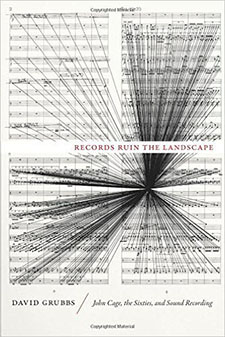 Peter Gena reads Records Ruins the Landscape: John Cage, the Sixties, and Sound Recording by David Grubbs. In this “excellent and meticulously researched book,” Grubbs examines “several early recordings along with a number of post-Cagian minimalists and free improvisers.” The volume is “highly recommended and a must-read for anyone probing new music and recordings.” Read the full review at caa.reviews.
Peter Gena reads Records Ruins the Landscape: John Cage, the Sixties, and Sound Recording by David Grubbs. In this “excellent and meticulously researched book,” Grubbs examines “several early recordings along with a number of post-Cagian minimalists and free improvisers.” The volume is “highly recommended and a must-read for anyone probing new music and recordings.” Read the full review at caa.reviews.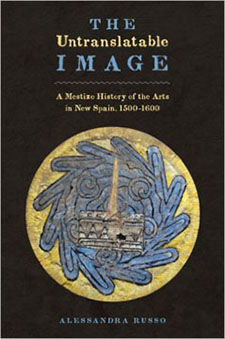 Eloise Quiñones Keber reviews Alessandra Russo’s The Untranslatable Image: A Mestizo History of the Arts in New Spain, 1500–1600. The author “extends and deepens her excursions into the creative and cultural dynamics of the art forms of early colonial New Spain” while advocating “their necessary place in contemporaneous Renaissance and early modern art history” in this “learned, insightful, and challenging” study. Read the full review at caa.reviews.
Eloise Quiñones Keber reviews Alessandra Russo’s The Untranslatable Image: A Mestizo History of the Arts in New Spain, 1500–1600. The author “extends and deepens her excursions into the creative and cultural dynamics of the art forms of early colonial New Spain” while advocating “their necessary place in contemporaneous Renaissance and early modern art history” in this “learned, insightful, and challenging” study. Read the full review at caa.reviews.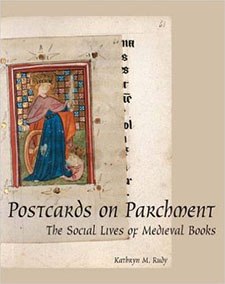 Sonja Drimmer examines Postcards on Parchment: The Social Lives of Medieval Books by Kathryn M. Rudy. Over the course of “three hundred riveting pages,” Rudy establishes “a new category of late medieval object, which she terms ‘parchment painting.’” The book is full of “intrepid flights of scholarship” and “like the manuscripts that it revives,” it “is prodigious with riches.” Read the full review at caa.reviews.
Sonja Drimmer examines Postcards on Parchment: The Social Lives of Medieval Books by Kathryn M. Rudy. Over the course of “three hundred riveting pages,” Rudy establishes “a new category of late medieval object, which she terms ‘parchment painting.’” The book is full of “intrepid flights of scholarship” and “like the manuscripts that it revives,” it “is prodigious with riches.” Read the full review at caa.reviews.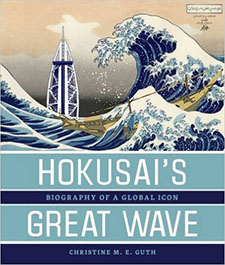 Gennifer Weisenfeld discusses Christine Guth’s Hokusai’s Great Wave: Biography of a Global Icon. “A landmark in multidisciplinary scholarly sophistication,” the volume “examines the long and storied history of one Japanese artwork as it has circulated around the world being imagined, reimagined, and reimaged, thereby fusing the local and global across time.” Read the full review at caa.reviews.
Gennifer Weisenfeld discusses Christine Guth’s Hokusai’s Great Wave: Biography of a Global Icon. “A landmark in multidisciplinary scholarly sophistication,” the volume “examines the long and storied history of one Japanese artwork as it has circulated around the world being imagined, reimagined, and reimaged, thereby fusing the local and global across time.” Read the full review at caa.reviews.caa.reviews publishes over 150 reviews each year. Founded in 1998, the site publishes timely scholarly and critical reviews of studies and projects in all areas and periods of art history, visual studies, and the fine arts, providing peer review for the disciplines served by the College Art Association. Publications and projects reviewed include books, articles, exhibitions, conferences, digital scholarship, and other works as appropriate. Read more reviews at caa.reviews.
News from the Art and Academic Worlds
posted by Christopher Howard — January 04, 2017
Each week CAA News summarizes eight articles, published around the web, that CAA members may find interesting and useful in their professional and creative lives.
Everything We Know about Whether and How the Arts Improve Lives
The platitudes are on the lips of every arts supporter, ready to be recalled at the first sign of a public hearing or potential funding cut. “The arts are essential—a necessity, not a luxury.” “The arts help kids learn.” “The arts are the foundation of the knowledge economy.” It feels good to say those things, but are they true? (Read more from Createquity.)
Networking the Humanities through Open Access, Open Source, and Not for Profit
Last month the Modern Language Association, in partnership with three other learned societies, launched the beta version of the expanded and now interdisciplinary Humanities Commons—a nonprofit network where humanities scholars can share their work in a social, open-access repository, discuss ideas, collaborate on common interests, and store research and teaching materials. (Read more from the Scholarly Kitchen.)
Eleven All-Important Things to Do before Leaving Art School
Graduating from art school means transitioning from the comfort of campus-provided studio space, access to production facilities, and a climate of constant feedback, criticism, and support to, well, having zero of those things. Abstaining from these perks cold-turkey can feel like quite the plunge—but luckily you can do a few things during your last semester to prepare for entering the “real world” as an artist. (Read more from Artspace Magazine.)
An Audit Nightmare Turned Artist Victory
American businesses sometimes lose money. Those losses create a tax shelter for other income. While the tax code explicitly provides this incentive for businesses—to encourage investment for growth and to allow for unpredictable events—losses that go on for too long tend to draw IRS scrutiny. The artist Susan Crile spent eight years in tax court defending her right to take losses. (Read more from Art F City.)
We Need a New Kind of Feminist Art
A quote that the Brooklyn Museum curator Catherine Morris often turns to is one by the artist and writer Emily Roysdon. “We are not protesting what we don’t want,” Roysdon once said about her queer activism, “we are performing what we want.” The idea of creating the world you want to live in, on a microcosmic level, is one that’s central to feminist theory, the history and methodology of which is closely intertwined with queer and civil-rights activism. (Read more from Artsy.)
The Gulf Art War
In 2005, in the gilded lobby of the Emirates Palace hotel in Abu Dhabi, the crown prince Mohammed bin Zayed al Nahyan described his vision for Saadiyat Island, a $27 billion development not far from the city’s downtown. Saadiyat, which Emiratis refer to as “the island of happiness,” would include luxury hotels, Marbella-style villas, and a boutique shopping quarter. Most important was a vast cultural district, and a new Guggenheim was to be a centerpiece of this effort. (Read more from the New Yorker.)
A Digital Billboard in Chicago Raises Questions about Art in the Public Sphere
Flashing brightly for a few seconds at a time, the black-and-white mugshot of an unnamed African American male loomed against the Chicago skyline, interrupting the mundane ads—for sandwiches, lawyers, Hondas—that shared space on the same digital billboard. I only just glimpsed it, peering from an overpass, but the haunting image has lingered with me ever since. (Read more from ARTnews.)
Is the Traditional Art Gallery Dead?
For the past several months, Artspace’s editors have persistently investigated the novel challenges and opportunities that the twenty-first century holds for the venerable brick-and-mortar gallery system, which has been shaken by both the shifting market and the disruptive power of the internet. Along the way, we’ve spoken at length to artists, dealers, advisors, and art-fair directors in an effort to take the pulse of the industry. (Read more from Artspace Magazine.)


